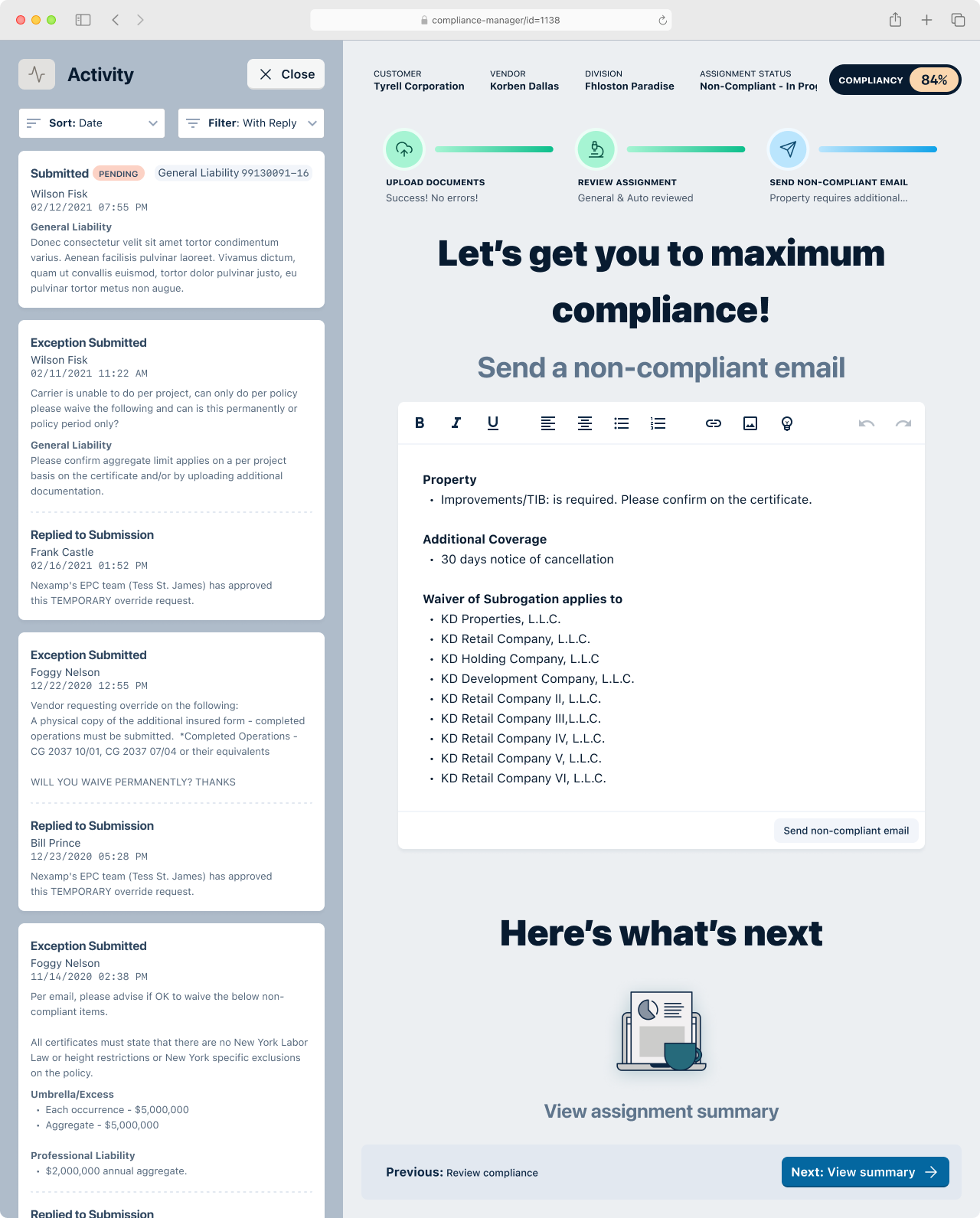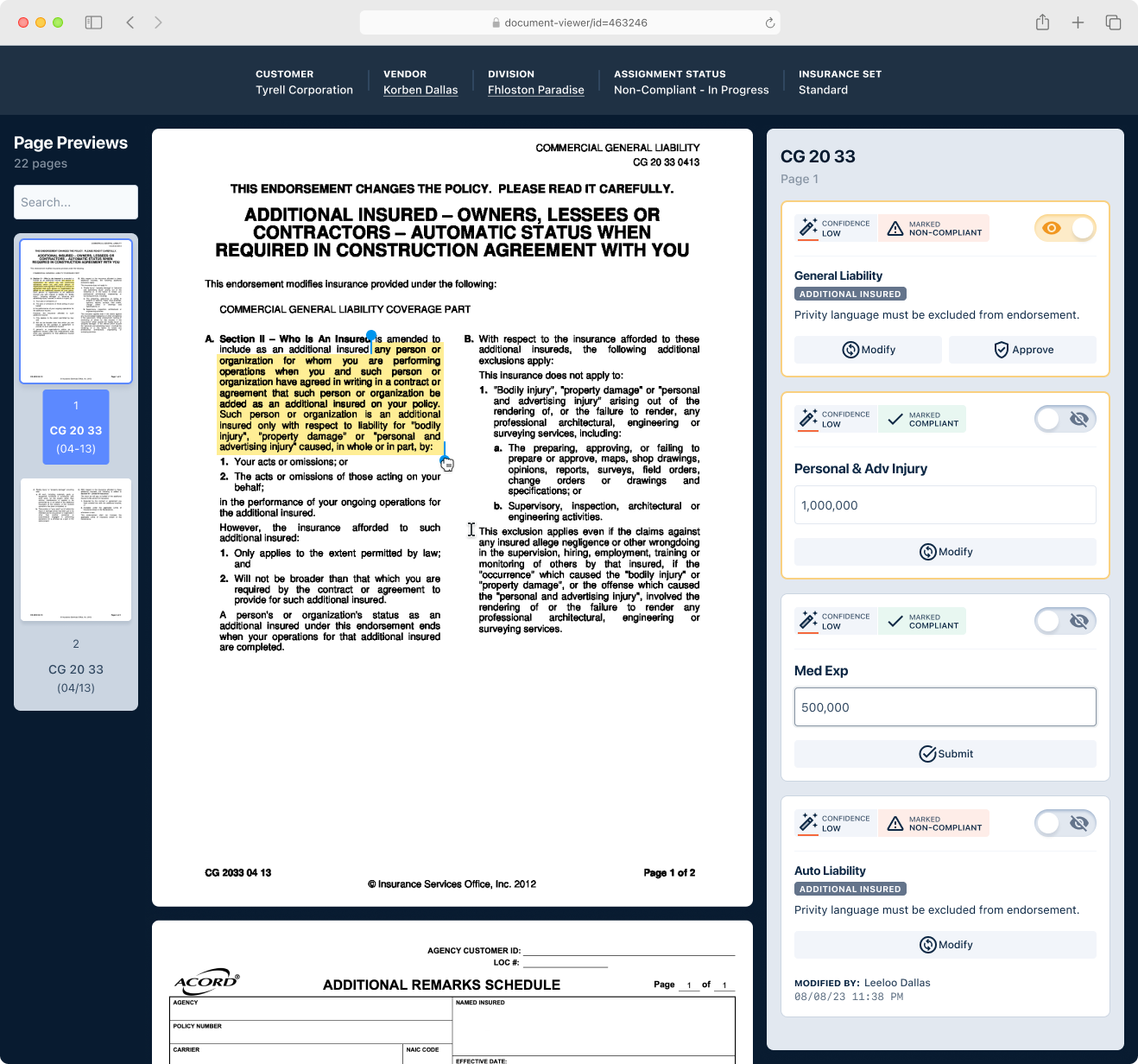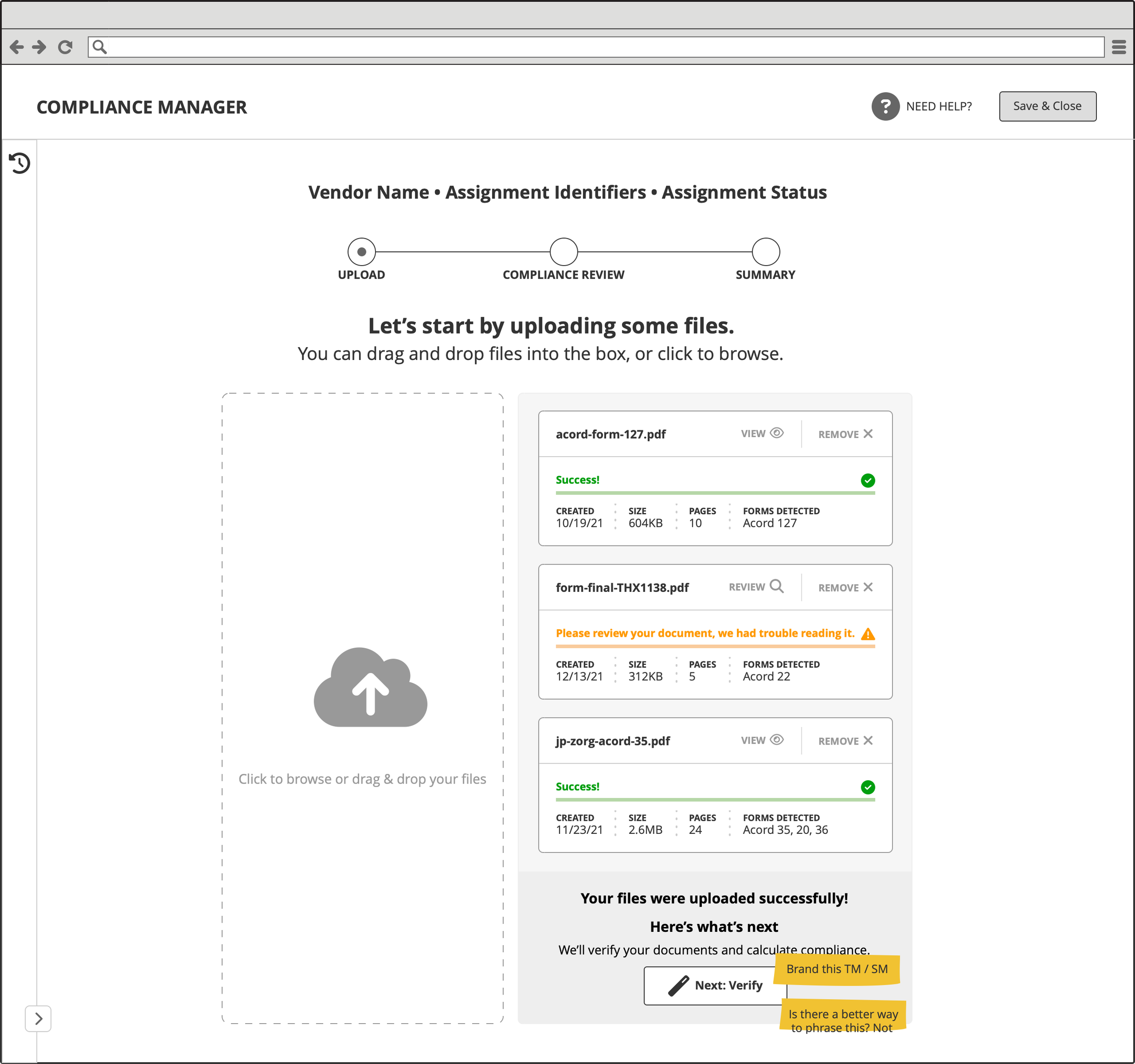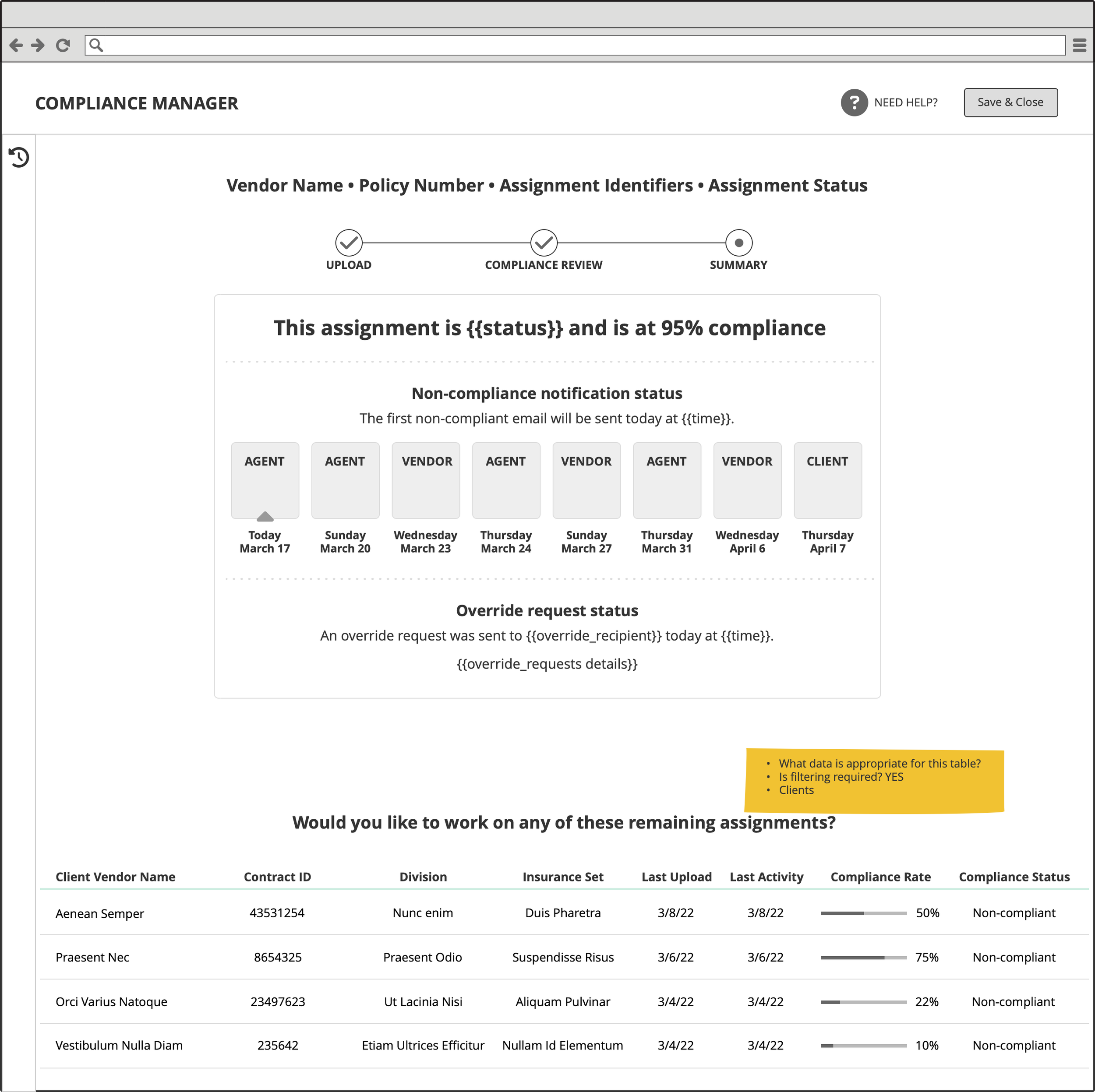Redesigning Compliance: A Story of Collaboration, Progress, and Possibility
Compliance management screen before UX improvements.
The Compliance Management Platform is a robust web-based SaaS application that handles insurance compliance by verifying certificates of insurance (COIs) against predefined requirements. Automating compliance checks and facilitating collaboration reduces operational inefficiencies and fosters stakeholder transparency.
Summary
Project
Incremental redesign of a B2B SaaS Compliance Management Platform.
Timeline
6 months
Collaboration
Worked with product managers, insurance experts, UX researchers, and an external agency.
Tools
Figma, FigJam, Balsamiq, HTML/CSS, Tailwind
Impact
Delivered a modernized UI and improved workflows, achieving a 35% increase in user engagement and reducing errors by 25%. Established the design and feature set for the future platform.
Target Users
Clients
Organizations submitting insurance compliance requirements.
Vendors
Businesses providing insurance documentation for verification.
Compliance Coordinators
Internal staff overseeing compliance decision-making.
Agents
Insurance representatives tracking compliance decisions.
InsureTech Administrators
Managers ensuring smooth platform operations.
Key Persona
Bridging the Gap Between Needs and Reality
I wasn't stepping into a blank slate when I joined the Compliance Management Platform project. An external agency had already conducted extensive UX research and compiled a treasure trove of insights.
There was a general sense of frustration and urgency. The Compliance Management Platform—a SaaS tool designed to streamline insurance compliance—had become deeply outdated, saddled with technical debt and a user bottleneck.
In our first collaborative meeting, the agency's lead researcher summarized their findings: "Users don't just want to complete tasks—they want to feel confident, informed, and supported." That insight resonated deeply with me. The platform's success would depend on more than functionality—it needed to deliver a transformative experience.
The upcoming challenge was ambitious: how could we transform a functional yet frustrating platform into one that felt intuitive and empowering in the short and long term?
My task was to work collaboratively with our internal team to deliver meaningful improvements that could make an immediate impact while keeping the long-term vision alive.
Project Timeline
My Role
As the Lead UX Designer for the Compliance Manager project, I contributed to the platform's growth. By collaborating with internal teams and an external agency, my responsibilities included research synthesis, design implementation, and cross-functional alignment.
Here's a breakdown of my contributions:
Vision and Strategy
Partnered with the product team, management, internal insurance experts, and UX researchers to establish a clear vision for the reimagined Compliance Manager.
Synthesized user insights from the external agency's research and internal feedback to define the platform's design principles and feature priorities.
Design and Implementation
Led the design of key updates, including the CSS reskin and incremental feature enhancements, to address immediate user pain points.
Created wireframes, prototypes, and high-fidelity designs with the external agency and internal development team.
Enhanced critical workflows, such as the policy line compliance panel and the in-app override submission process, ensuring usability and alignment with technical constraints.
Collaboration and Stakeholder Alignment
Bridged communication between cross-functional teams, including product managers, developers, and subject matter experts, to align design decisions with business and user needs.
Acted as a liaison between the external agency and internal teams, ensuring research findings translated effectively into actionable solutions.
Iterative Improvements
Conducted user testing and incorporated feedback to prioritize and implement secondary improvements, such as collapsible panels and enhanced tooltips.
Focused on delivering measurable impact within tight constraints, laying the foundation for a fully reimagined Compliance Manager.
By taking a user-centered approach and fostering collaboration across diverse teams, I helped establish a shared vision. I delivered meaningful updates that addressed immediate challenges while paving the way for future innovation.
Stepping Into Complexity
Inefficiencies & Friction
The agency's research revealed a landscape full of inefficiencies:
Override Processes
Override request process was complex and opaque, leading to delays and miscommunication.
Cluttered Interfaces
Navigating the platform required constant side-to-side mouse movements, with key information buried in confusing layouts.
The Success Gap
Users were completing tasks but often needed clarification about the outcomes, eroding trust in the platform.
Eroding Confidence
Users often completed tasks but still felt unsure about the results, creating a trust deficit.
Workflows in Need of Help
We spent weeks digging into their findings. Persona workshops highlighted the distinct needs of key roles like compliance coordinators, contract administrators, and risk managers. These users didn't just need a tool—they needed clarity, confidence, and simplicity in their workflows.
One quote from a compliance coordinator stayed with me:
"It feels like I'm constantly juggling—I just want to know everything's on track without triple-checking."
That frustration became our guiding light: reduce friction, build trust, and deliver transparency.
Painpoints
Phase 1: Small Wins, Big Foundation
The priority was addressing immediate pain points. Working with the internal team, I tackled a CSS reskin to modernize the platform's look and feel.
Key Improvements
Consistent typography and button design improved readability.
Collapsible panels gave users control over their workspace, reducing visual clutter.
More clearly defined compliance action switches.
Cleaner presentation of document info.
Easier to read requirements.
While these changes didn't rewrite the platform, they showed users that we were listening and laying the groundwork for greater transformations.
Phase 2: Incremental Impact Through Collaboration
This phase was all about maximizing impact with limited resources. I worked closely with internal users and the product manager to implement targeted changes based on their feedback.
Highlights:
Reduced the space required for the policy line compliance panel while improving the visibility of individual policies.
Introduced collapsible sections, larger fonts, and streamlined navigation to make decision tracking easier in the history panel.
Increased the number of visible requirements while enhancing the ability to scan and make decisions on each requirement quickly.
Filters were introduced to the policy line compliance, history notes, insurance policies, and insurance requirements panels.
Enhanced the readability of the document info panel by creating more distinct sections and providing additional information.
Phase 3: The Vision
I collaborated closely with the product team, management, internal insurance experts, and UX researchers to define the design and features of the future Compliance Manager.
This teamwork has established a foundation for a user-centered platform that addresses both current challenges and future requirements.
The planned Compliance Manager will include
Role-Based Dashboards
Tailored experiences for clients, vendors, and coordinators, reducing cognitive load.
Adaptive Workflows
Personalized workflows for different user roles (clients, vendors, coordinators) with predictive task suggestions based on past actions.
AI-Powered Insights
Machine learning recommendations for resolving non-compliance issues, suggesting likely documents or additional information needed.
Document Auto-Parsing
AI-based parsing of uploaded documents to auto-fill critical fields and validate compliance against requirements
Streamlined Override Management
Automated tools to submit, track, and resolve override and exception requests, with real-time notifications and a centralized dashboard.
Proactive Compliance Forecasting
Predictive analytics to warn about potential compliance lapses before they occur based on policy expiration trends or missing documentation.
Enhanced Collaboration Tools
Real-time commenting and chat features within assignments to reduce reliance on external communication tools.
Multi-Assignment Management
Tools for batch processing compliance checks across multiple assignments, reducing repetitive tasks.
Comprehensive Audit Trail
A user-friendly history panel with advanced filters to track all actions, notes, and decisions in a single view.
Wireframes & Visuals





Results That Resonate
Even without the complete reimagining, the updates have made a measurable difference:
• 35% increase in user engagement with compliance updates.
• 25% reduction in compliance errors.
• 30% decrease in unnecessary communication.
What I Learned: Turning Constraints Into Opportunities
Reflecting on this project, I'm proud of what we accomplished within real-world constraints. The combination of legacy technical debt and limited resources forced us to focus on what mattered most: listening to users, prioritizing their needs, and collaborating across teams to deliver meaningful improvements.
Working with both the external agency and our internal teams underscored the value of diverse perspectives. By uniting their strategic vision with our practical know-how, we solved immediate problems and set the stage for future success.
This project isn't just about improving a platform. It's about building trust—one small, impactful change at a time.













